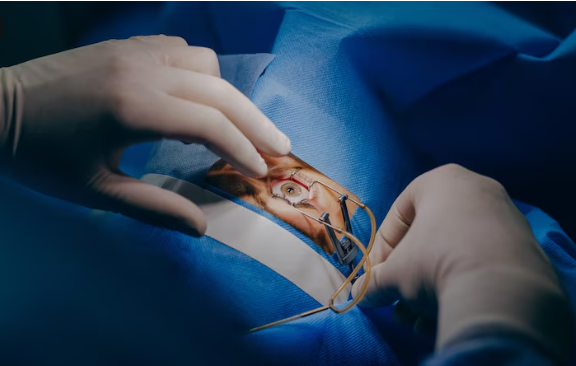Imagine learning that your lost tooth might hold the secret to your vision recovery. Osteo-odonto-keratoprosthesis (OOKP), also referred to as “tooth in eye” surgery, is a real, cutting-edge medical procedure that has been giving sight to patients who have run out of other options. It may sound like something from a science fiction book.
This procedure, which was first developed in the 1960s by Italian ophthalmic surgeon Benedetto Strampelli, is only performed on patients who have significant corneal damage, especially if their eyes are no longer able to receive corneal transplants. Despite being a multi-stage, intricate procedure, the success rates are exceptionally high, providing long-term vision restoration.
What is Tooth in Eye Surgery?
| Aspect | Details |
|---|---|
| Procedure Name | Osteo-odonto-keratoprosthesis (OOKP) |
| Developed By | Dr. Benedetto Strampelli (1960s) |
| Purpose | Restores vision in patients with severe corneal damage |
| Ideal Candidates | Patients with damaged corneas but a healthy retina and optic nerve |
| Number of Stages | Two |
| Success Rate | High—many patients maintain vision for decades |
| Countries Offering OOKP | UK, Australia, Japan, Germany, India, Canada |
🔗 More Information on OOKP , Wikipedia
How Does Tooth in Eye Surgery Work?
Unlike conventional corneal transplants, which rely on donated tissue, OOKP uses a patient’s own tooth to anchor an artificial lens into the eye. The procedure unfolds in multiple stages, requiring months of recovery before full vision restoration.
🔹 Step 1: Preparing the Tooth and Eye
- A canine tooth is extracted and shaped into a thin lamina.
- A small optical lens is implanted into the tooth, forming a composite that can be placed inside the eye.
- The tooth-lens structure is inserted into the patient’s cheek for several months, allowing it to develop a natural layer of living tissue.
🔹 Step 2: Preparing the Eye for the Implant
- A graft of cheek tissue is sewn onto the eye, forming a protective barrier.
- The damaged iris, lens, and cornea are removed to create space for the new implant.
🔹 Step 3: Transferring the Tooth-Lens Structure to the Eye
- The tooth-lens complex is removed from the cheek and placed inside the eye.
- The optical cylinder aligns with the cornea, allowing light to enter.
- The cheek tissue is repositioned, with a small hole cut to allow vision.
Who Can Benefit from OOKP Surgery?
This surgery is reserved for patients suffering from extreme corneal blindness who cannot receive standard corneal transplants.
👁️ Ideal candidates include:
✔️ Patients with severe corneal scarring from burns, trauma, or disease.
✔️ Individuals suffering from Stevens-Johnson syndrome, a rare disorder that causes extensive eye damage.
✔️ People who have failed multiple corneal transplants but retain a functional retina and optic nerve.
🚫 Who is NOT a suitable candidate?
❌ Those with optic nerve damage (OOKP relies on the optic nerve to transmit signals to the brain).
❌ Patients with retinal disease that prevents visual processing.
Recovery After Tooth in Eye Surgery
🔹 The First Week
- Patients must remain lying on their back to ensure proper healing.
- Medications such as antibiotics, steroids, and blood pressure stabilizers help prevent complications.
🔹 The First Month
- Weekly check-ups are required to monitor healing and adjust medications.
- Patients may experience mild discomfort and sensitivity to light.
🔹 Long-Term Care
- After one year, check-ups become less frequent, occurring every few months.
- Patients visit a prosthodontist to replace the missing tooth used in the procedure.
- The tooth-lens implant remains functional for decades, ensuring long-lasting vision.
How Effective Is Tooth in Eye Surgery?
📊 Studies show that OOKP has one of the highest success rates among vision restoration surgeries.
🔹 Success Rate: 85-90% of patients regain functional sight.
🔹 Longevity: Many patients maintain clear vision for 20+ years.
📌 A Real-Life Example:
👩 Gail Lane, 74, lost her sight due to Stevens-Johnson syndrome. After OOKP surgery in Canada, she regained vision after 10 years of blindness—an outcome that seemed impossible before the procedure.
Why Use a Tooth Instead of an Artificial Implant?
At first glance, using a tooth in the eye sounds unusual, but there are strong scientific reasons behind this approach.
🦷 Biological Compatibility
- Since the tooth comes from the patient’s own body, the risk of rejection is minimal.
- Unlike artificial implants, the tooth remains stable and integrates well with eye tissue.
👁️ Durability & Strength
- The dense material of a tooth provides a strong anchor for the optical lens.
- It withstands moisture exposure and does not degrade over time.
Is Tooth in Eye Surgery the Future of Vision Restoration?
While OOKP remains a rare and complex procedure, its high success rate and long-term durability make it a viable option for those with no alternatives. With ongoing advancements in biotechnology and ophthalmic surgery, more refined versions of OOKP may emerge in the near future.
🌍 Countries currently offering OOKP include:
✔️ United Kingdom
✔️ Australia
✔️ Germany
✔️ Japan
✔️ India
✔️ Canada
Although still performed at specialized centers, more ophthalmologists and surgeons are training in OOKP techniques, ensuring wider accessibility in the coming years.


